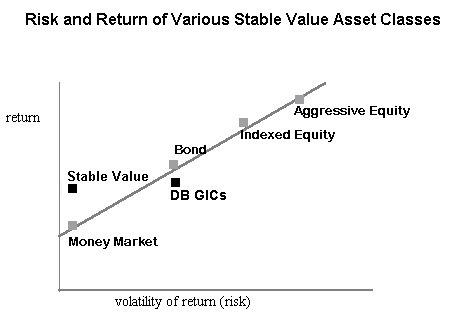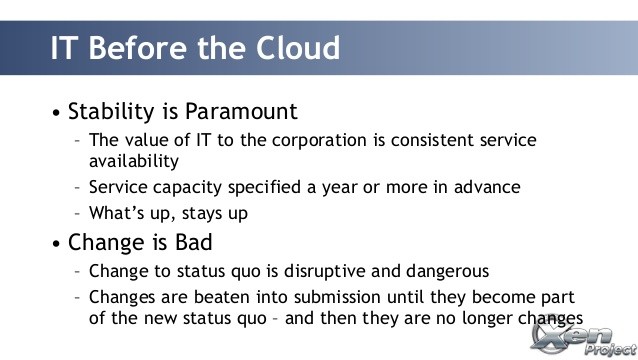Stable Value and GICs Q&A Table of Contents
Post on: 16 Март, 2015 No Comment

Stable value funds are one of the most popular investment options in defined contribution plans and the most popular conservative or fixed income option. This popularity stems from the fact that they offer participants the principal stability of a money market fund with average returns comparable to those of an intermediate-term bond fund. The market value risk on participant transactions (the risk of any gains or losses on assets sold to pay benefits to participants at book value) is borne by a high-quality financial institution which issues the investment contracts that fund the option. This principal stability makes the asset class and excellent diversifier of investment risk as well as a good investment option for funds which may be needed in the relatively near term. The recent turbulence in investment markets demonstrates the importance of these characteristics.
The stable value asset class is unique in being found almost exclusively in 401(k) and other defined contribution plans. It evolved from GICs and other group annuity contracts sold originally to defined benefit plans. Pension accounting rules gave these contracts book value treatment, which made it possible to extend principal protection to participants. Issuers are uniquely able to underwrite this benefit in defined contribution plans because of the arbitrage constraints which can be imposed by plan rules [See Qs 19, 22] and deterrent effect of losing company matches and tax benefits from switching out of the plan.
Q1 What is a stable value fund?
Stable value funds are options offered by 401(k) and other defined contribution plans, typically as the most conservative investment option. These funds are invested in GICs and other medium-term fixed-income investment contracts which offer participants the ability to withdraw or transfer their funds subject to plan rules without any market value risk (risk of principal loss as interest rates rise) or other penalty for premature withdrawal. The issuer of the investment contracts, a high quality investment institution, provides this book value liquidity on participant transactions and also guarantees principal plus accumulated interest and an interest rate for a specified period of time.
In the past the stable value option was usually called the GIC or guaranteed option. However, since the advent of many new types of investment contracts for these funds, fund names such as stable value, fixed income, or interest income are more frequent.
Historically, stable value has been the most popular conservative defined contribution investment option. A 2001 Hewitt Associates survey reported that 69 percent of defined contribution plans offered a stable value option.
As of year-end 2001, allocations to stable value funds were 29 percent of plan assets in those plans where it was offered, according to a survey by the Stable Value Investment Association.
Q2 Why are stable value funds popular with defined contribution participants but not institutional investors?
No other medium-term investment offers liquidity without any market value risk or interest rate penalty, and this favorable risk/return tradeoff is only available to defined contribution plan participants, which explains why their relative popularity is limited to this investment group. Stable value investment contracts do not provide principal safety to the pension plan contractholder. Investment contracts in defined benefit plans must generally be reported at market value (see Q 37), and plan-initiated withdrawals from the contracts are honored either at market value or at the lesser of book or market (see Q 34). In fact, because stable value contracts are non-assignable private placement investments which cannot be readily traded or marketed by the contractholder, they have less liquidity than corporate bonds of similar yield and credit rating. This gives them a slightly worse defined benefit risk/return profile than other fixed income investments, accounting for their low concentration in defined benefit plans (see Figure 1).
figure 1
Q3 What types of people should invest in a stable value fund?
The stable value option is attractive to two types of defined contribution participants: those seeking principal safety and those seeking to diversify their investments. Many of the largest plan balances are owned by retirees or those nearing retirement who may need the security of knowing that their assets are protected from market value risk. Many younger participants lack savings outside the plan and need assets with principal safety to cover contingencies. Others may intend to use their balances in the near term to invest in a home or education, alternative ways to invest in their retirement security. Stable value funds offer this principal safety in combination with a good rate of return.

In addition, the principal stability offered participants by stable value funds provides better diversification with equities than other conservative investment options typical in defined contribution plans. This means that overall portfolio risk to the investor can be reduced by investing in a combination of stable value and equities. (see Q4).
Q4 How does the performance of stable value funds compare with that of other conservative options for defined contribution investors?
Stable value funds tend to have average returns comparable to those available on medium-term bond funds, but with much less volatility in annual earnings. Because the option is invested in medium-term assets (see Q 5), the returns are higher on average than those available on a money market fund. This is illustrated in Figure 2, which shows that over the period 1983-2000, the stable value portfolio had returns well in excess of the 6-month certificate of deposit and far less volatile returns than the intermediate government bond index, which experienced a loss in one year during this period.
The five-year GIC Index compiled by Deutsche Asset Management consists of a portfolio that invests monthly in a stable value instrument with a maturity of 5 years and is held to maturity, so that the effective duration of the portfolio is about 2.5 years. The average return for this index over the last ten years was 7.02 percent, compared to 6.77 percent for the Lehman Intermediate Government Index and only 5.00 percent for the money market proxy.
The low volatility in stable value returns increases the diversification benefits it offers with other typical investment options for defined contribution plans, especially common stocks. One measure of good diversification between asset classes is a low correlation of returns, showing that the performance cycles of the assets differ. Table 1 shows that stable value returns have a much lower correlation with stock market movements than bonds.
This low correlation means that stable value investors may have a higher concentration of equities at the same level of downside risk than if they invested in a market value bond fund. In fact, a 401(k) investor with a 10-year time horizon could shift from a portfolio with 40 percent invested in a medium-term bond fund and 60 percent in common stocks to one with only 30 percent stable value and 70 percent in stocks with a 95 percent certainty that annual losses would not be increased. Not surprisingly, expected returns are higher on the stable value/equity portfolio as well, 14.4% per year compared to 14.37% on the stock/bond mix. 1














